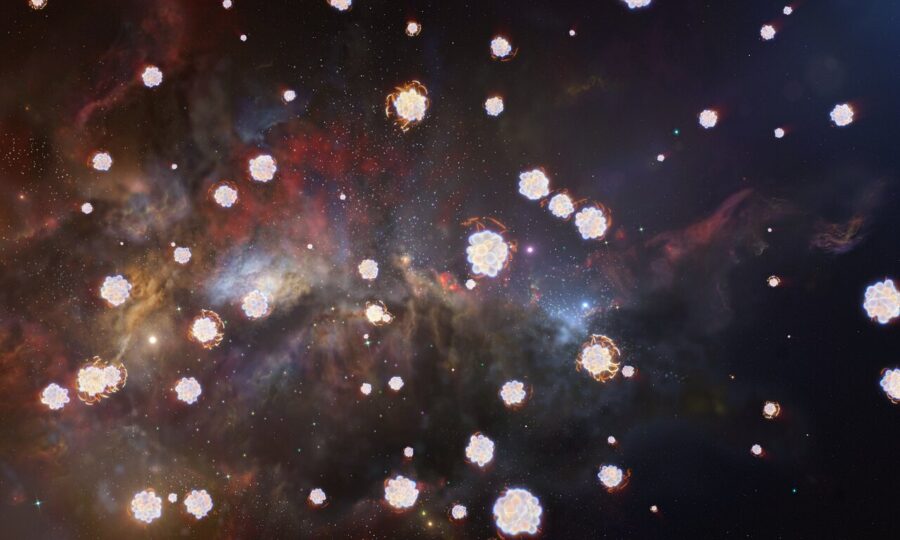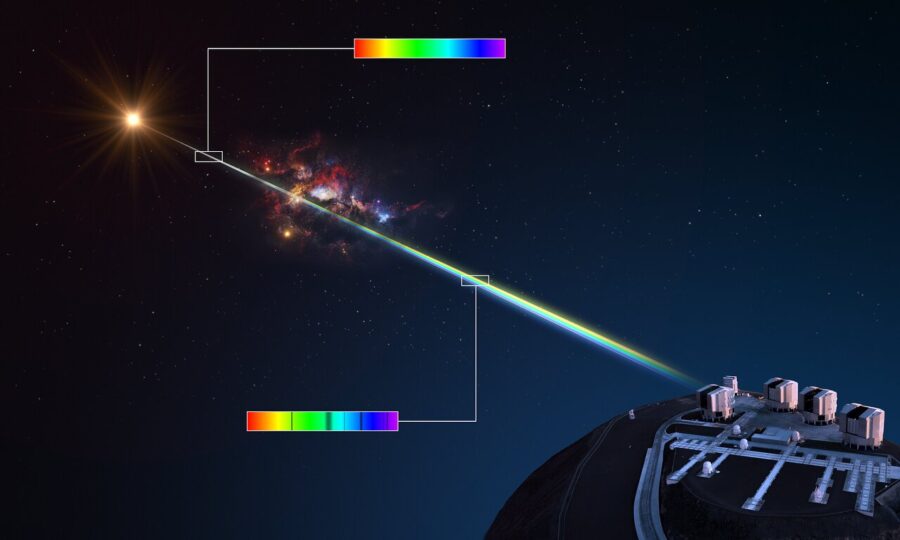The first stars are too faint and far away to detect directly, but their gaseous remains can be seen absorbing the light of distant galaxies.

ESO / L. Calçada, M. Kornmesser
Long-lived stars with a distinctive chemical fingerprint left over from the early universe abound in the stellar halo that surrounds the Milky Way Galaxy. Now, astronomers have taken one step further back into history, spotting three similarly fingerprinted gas clouds — from which such stars form — less than 2 billion years after the Big Bang.
“For the first time ever, we were able to identify the chemical traces of the explosions of the first stars in very distant gas clouds,” says graduate student Andrea Saccardi (University of Paris and University of Florence).
We can’t detect the very first stars directly. They formed out of only hydrogen and helium (and a smattering of lithium) a couple hundred million years after the Big Bang and were far more massive than modern-day stars. According to simulations, a single star could be equivalent to tens or even hundreds of Suns. But though they burned bright, they survived only briefly before coming to somewhat anti-climactic ends.
The earliest supernovae barely managed to explode. They were faint, and they failed to eject all their layers of fused elements — the innermost shells that contained the heaviest elements (most notably, iron) fell back onto the star. As a result, these stars enriched their surroundings with carbon and other light elements, but not with iron. The next generation of stars was thus iron poor, just like the first stars, but they would have had higher amounts of carbon, oxygen, magnesium, aluminum, and silicon.
Since the early 1990s, astronomers have detected many stars with exactly this fingerprint in the halo of the Milky Way. These later generations of stars represent the light, long-lived leftovers of an earlier era. Based on their existence, astronomers figure that clouds with similar chemical composition should exist in the early universe. But searches to date turned up empty.
Saccardi and collaborators took another stab at the search, this time searching for more spread-out clouds. These thin, isolated clouds are less likely to have formed subsequent stellar generations, thus preserving the chemical signatures of the first stars.
To find such clouds, the team looked at quasars observed with the European Southern Observatory’s Very Large Telescope in Chile. These distant feeding black holes that act as beacons whose light is seen across the universe. Any intervening clouds act like a fog in front of a searchlight, dimming its light at certain wavelengths.

ESO / L. Calçada
The team reports in the Astrophysical Journal that, from a study of 37 clouds, they found 12 that were iron-poor; three of those clouds were also relatively rich in carbon and other light elements. The three clouds, all from less than 2 billion years after the Big Bang, have similar chemical composition to the low-mass stars in the Milky Way halo, which means they hold the remains of exploded first-generation stars.
“Our discovery opens new avenues to indirectly study the nature of the first stars, fully complementing studies of stars in our galaxy,” explains team member Stefania Salvadori (University of Florence).
Timothy Beers (University of Notre Dame), who reviewed the publication, says, “This is by far the most comprehensive effort of its kind to date, and it provides a path for future studies to obtain similar data to refine our understanding even more.”
 1
1








Comments
Rod
May 5, 2023 at 11:53 am
This is a very interesting model interpretation of some metal observations. The metals are interpreted within a model for Pop III supernovae. Ref - Evidence of First Stars-enriched Gas in High-redshift Absorbers*, https://iopscience.iop.org/article/10.3847/1538-4357/acc39f, 03-May-2023.
My observation. *The chemically pristine gas* has not been seen in nature, always some metal content is observed. From the paper, "1. Introduction Cosmological simulations show that the first (Population III) stars are likely more massive than present-day “normal” stars, with a characteristic mass of ∼10Msun and a maximum mass possibly extending up to ∼1000Msun (e.g., Hosokawa et al. 2011; Hirano et al. 2014). Among such a variety of stellar masses there are many channels to produce supernovae (SNe) and thus to contaminate the surrounding environment with the heavy elements newly produced by Population III stars." My note, other models now use 10,000 and 100,000 solar mass Population III stars as seeds to create SMBHs in galaxies. Redshift ranges used in the paper are some 3 to 4.5 z. At redshift 4.5, the universe age after BB is 1.352 Gyr, light time or look back distance = 12.370 Gly, and comoving radial distance = 24.957 Gly. Using H0 = 69 km/s/Mpc, space is expanding at 1.7611313E+00 or 1.76 x c velocity. Plenty of variables and parameters used to interpret the metals found in the gases as arising from a population of primordial supernovae created by Population III stars. Good effort here, so far Population III stars continue to remain unobserved and no spectrums for them either.
You must be logged in to post a comment.
You must be logged in to post a comment.